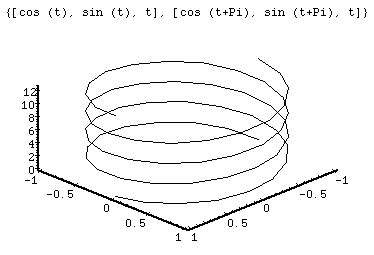Function
{[ x(t) = cos(t), y(t) = sin(t), z(t) = t ], [ x(t) = cos(t+Pi), y(t) = sin(t+Pi), z(t) = t ]}
Domain
t is an element of the set of all Real numbers
Graphs

Derivative
With respect to t: {[-sin(t), cos(t), 1], [sin(t), -cos(t), 1]}Critical points are formed where all the derivatives equal 0. These critical points may be minimums, maximums, or saddle points. Since 1 will never equal 0, there will be no critical points. This means that there are no minimum or maximum points. This is the same for both equations.
Integral
With respect to t: {[sin(t), -cos(t), ( 1/2 )t2], [-sin(t), cos(t), ( 1/2 )t2]}
Interesting Features
This plot shows a double helix. The plot contains the standard helix and a second helix rotated Pi radians around. This is very similar to the double helix structure found in human DNA.
Back to top
Back to main page